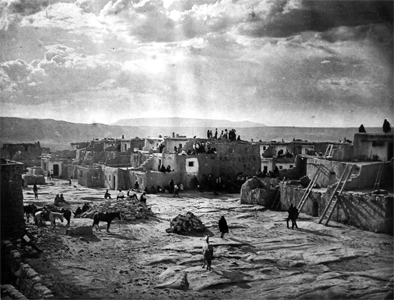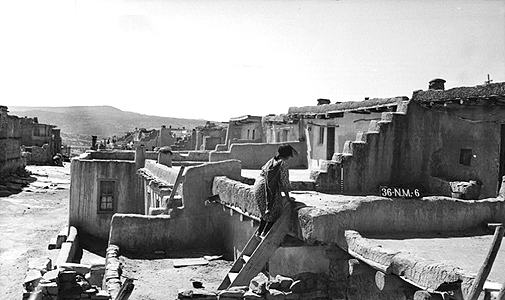
VIRTUAL REALITY ARCHAEOLOGY


Left: Acoma Fiest Day. Photo by Edward Curtis. Right: Image courtesty of Library of Congress from 1933 HABS Survey, Perry E. Borchers, photographer.
Ancestral Acoma Culture, located near Gallop, New Mexico; this is one of the longest continuously inhabited villages within the United States; after the destruction of the original village, by Spanish cannon, dating from the 10th century C.E., the village was reconstructed with its current streets and alignments--site layout and design guidelines set by the Conquistadors. Acoma Pueblo's south facing room blocks thus have an optimal orientation for passive solar energy gain. The village, called "Sky City", is set atop a free-standing mesa 370 feet (113 meters) above the surrounding valley floor.
Materials: stone and adobe walls, wood log roof support structure, with mud/clay roof over sappling matting.
Data for CG model:
1. Nabokov, Peter, 1986. ARCHITECTURE OF ACOMA PUEBLO - THE 1934 HISTORIC AMERICAN BUILDINGS SURVEY PROJECT, Ancient CIty Press, Santa Fe, NewMexico,
The HABS 1934 ACOMA MODEL
In 1934, a group of unemployed architects from Colorado got a federal grant to measure important native cultural architecture in the Southwest. Acoma Pueblo, one of the oldest continuously inhabited places in the US, was selected for study. The Elders of the Pueblo permitted the architects to measure all buildings on the outside surface, but only three houses on the inside.
During the 1998-99 winter months, I began work on the computer reconstruction of Acoma Pueblo (Sky City) using data from the drawings and measurements made in the 1934 Historic American Buildings Survey Project (HABS). This was a slow and painstaking project, however, during the many hours I spent in construction, I began to experience Old Acoma with a sense of place in the details. This detail is what I have been looking for in my efforts to recreate Native American places. Thanks to the HABS architects; this detailed information was an invaluable archive, and it has been an honor and privilege to be able to experience this place with this detail.






